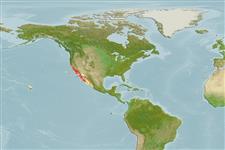Elasmobranchii (hajar och rockor) (sharks and rays) >
Carcharhiniformes (Ground sharks) >
Pentanchidae (Deepwater catsharks)
Etymology: Parmaturus: parma (L.), from parme (Gr.), small shield; oura (Gr.), tail, presumably referring to upper edge of caudal fin “armed with modified” scales (per Garman 1913). (See ETYFish); xaniurus: xanion (Gr.), comb for carding wool; oura (Gr.), tail, referring to crest-like row of tooth-like projections along upper edge of caudal fin. (See ETYFish).
More on author: Gilbert.
Environment: milieu / climate zone / depth range / distribution range
Ekologi
marina djupbottenlevande; djupintervall 88 - 1250 m (Ref. 96339). Subtropical; 39°N - 20°N
Eastern Central Pacific: central California, USA to the Gulf of California.
Length at first maturity / Size / Vikt / Age
Maturity: Lm 45.0, range 43 - 47.5 cm
Max length : 45.0 cm TL hane/ej könsbestämd; (Ref. 244); 55.0 cm TL (female)
Found on the outer continental shelf and upper slope. Feeds on a variety of small fish (e.g. lanternfish) and invertebrates. Oviparous. Possesses an enlarged gill region which is an adaptation to areas with low dissolved oxygen levels. Has a high concentration of squalene in its liver which affords it neutral buoyancy. Regularly caught by bottom trawlers but not utilized at all.
Life cycle and mating behavior
Könsmognad | Reproduktion | Lek | Ägg | Fecundity | Larver
Oviparous, paired eggs are laid. Embryos feed solely on yolk (Ref. 50449).
Compagno, L.J.V., 1984. FAO Species Catalogue. Vol. 4. Sharks of the world. An annotated and illustrated catalogue of shark species known to date. Part 2 - Carcharhiniformes. FAO Fish. Synop. 125(4/2):251-655. Rome: FAO. (Ref. 244)
IUCN Red List Status (Ref. 130435)
Threat to humans
Harmless
Human uses
Fiskeri: saknar intresse
Ytterligare information
Age/SizeTillväxtLength-weightLength-lengthLength-frequenciesMorfometriMorfologiLarverLarvdynamikRekryteringAbundansBRUVS
referenserVattenbrukVattenbruksprofilAvelslinjerGenetikElectrophoresesÄrftlighetSjukdomarBehandlingNutrientsMass conversion
MedarbetareBilderStamps, Coins Misc.LjudCiguateraHastighetSimsättGälytaOtolithsHjärnstorlekSyn
Verktyg
Special reports
Download XML
Internet-källor
Estimates based on models
Preferred temperature (Ref.
123201): 6 - 14.9, mean 7.9 °C (based on 29 cells).
Phylogenetic diversity index (Ref.
82804): PD
50 = 0.5010 [Uniqueness, from 0.5 = low to 2.0 = high].
Bayesian length-weight: a=0.00282 (0.00160 - 0.00498), b=3.08 (2.92 - 3.24), in cm total length, based on LWR estimates for this species & (Sub)family-body (Ref.
93245).
Trofisk nivå (Ref.
69278): 3.8 ±0.0 se; based on diet studies.
Resiliens (Ref.
120179): Låg, lägsta populationsfördubblingstid 4,5-14 år (Fec assumed to be <100).
Fishing Vulnerability (Ref.
59153): Moderate vulnerability (42 of 100).
